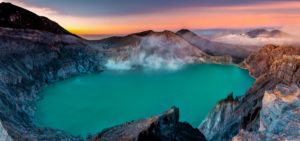
When we think of volcanoes rarely does the colour blue come to mind. We might be more inclined to think of the red in line with the flowing lava we have seen before, but I doubt many of us would associate blue flames burning or a lake so acidic that it is a brilliant blue-green colour. All of this is unless you are familiar with the popular tourist spot of Kawah Ijen Volcano, known for its beautiful display of glowing blue flames at night and a lake in its crater that looks more like a beautiful blue ocean than a volcano – although many say it looks as though the volcano has blue lava.
Kawah Ijen Volcano, located to the east of Java Island in Indonesia, is an active volcano with a bizarre blue lake that brings tourists across the globe to view its natural wonder. The Ijen volcano is made up of close to 10 stratovolcanoes, that enclose the Kava Ijen Lake which has become famous for its bizarre blue-hued water. The water is turned blue due to the hydrogen chloride which is spouted from the volcano beneath the lake. When this gas comes into contact with the lake it causes the blue hue and so forms the world’s largest hydrochloric acid lake in the world. Depending on the volcanic activity, the lake can vary in colour from turquoise, to green or even grey. The lake sits at a PH of 0.5 and the release of sulphur has made the air surrounding it extremely toxic. Therefore, visiting the volcano as a tourist comes with risk, and requires the need for respiratory equipment to be able to marvel at its sight.
One of the truly beautiful features of the volcano comes at night when blue flames can be seen flickering around the volcano. This naturally occurring phenomenon happens as sulphur is produced from the volcano as a gas, which upon being released is then exposed to the incredibly high temperatures of the volcanic atmosphere which ignites the sulphur and so the flame burns blue. As the volcano remains active it is a beautiful wonder to experience but remains a deadly place to be. Not to mention the toxic air quality due to the number of poisonous gases being produced, but the volcano often experiences phreatic eruptions. These eruptions do not often cause significant damage, but they do risk the lives of those visiting and so sometimes visiting the volcano to see the wonder of the blue lake or flames is dangerous. The volcano remains under constant observation for signs of an eruption, and every precaution is taken before tourist groups can visit.
However, the volcano due to its sulphuric gases makes it a crucial spot for sulphuric mining. When sulphur is molten it glows red a lot like lava, however as it cools on the ground it becomes bright yellow and hard. Miners break this cooled material, taking it away from the volcano and to local sulphur refineries. The mining process then is incredibly dangerous, as miners are risking their lives trying to make a living from the sulphur refineries. Although, unlike tourist groups, miners do not go near the volcanos with respiratory equipment, instead they are dangerously putting their lives at risk to make a wage. The mining at Kawah Ijen is surrounded by issues of exploitation, child labour, inadequate equipment, and health issues, as many miners experience lung diseases and chest infections from being forced to mine in such dangerous conditions. Therefore, whilst the volcano boasts great beauty, there is a danger that comes with such a natural phenomenon.
Overall, Kawah Ijen volcanic fires and Kava Ijen Lake have some of the most remarkable natural activity in the world making them a must-see destination for many travellers in Indonesia. Whilst, other volcanoes are also known for their blue lava, Kawah Ijen is the most consistent so remains at the top spot for tourism. Like many natural wonders, there comes a dangerous and dark side, as we have seen with the harmful and often exploitative nature of sulphur mining that takes place around the volcano. Therefore, Kawah Ijen is a dangerous beauty on the bucket list of sights to be seen, but what a sight it is. Providing proper safety and monitoring is carried out, it makes it a must-visit destination for any volcano enthusiast and natural wonder seeker.







